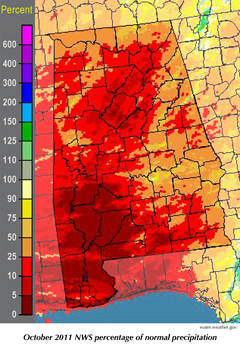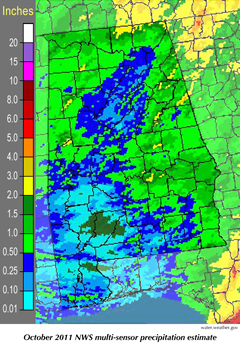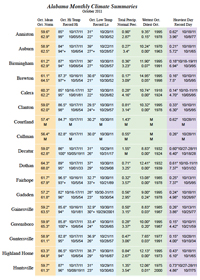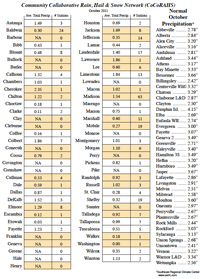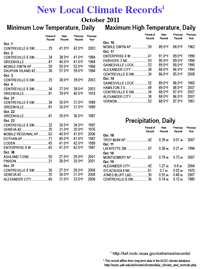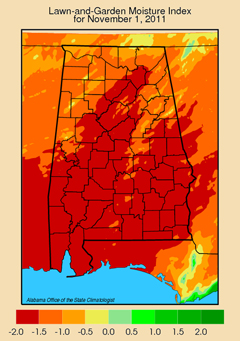 |
|||||||||||||||||||||||||||||||||||||||
Volume 2, Number 1, October, 2011 |
|||||||||||||||||||||||||||||||||||||||
|
October is usually a dry month in Alabama; it is the only month when normal rainfall in a large number of counties is less than three inches. This October was dry even by October's standards. Mobile saw less than one tenth of an inch of rain for the entire month. Two CoCoRaHS stations in Clarke County reported eleven one hundredths of an inch, while the only station in Escambia County that reported last month saw 0.12 inches in October. Several sites across the state had about one quarter of an inch. October 2011 was also below average, temperature wise. As might be expected, drought is back with a vengeance. Just over three quarters of the state is in some level of drought, with 40 percent of Alabama in either severe or extreme drought conditions. The cold front that moved across the state last week brought with it some rain, but we are still significantly behind where we would like to be in rainfall for this fall. The forecast for this winter isn't encouraging. A La Niña Pacific Ocean cooling event is setting up in the ocean west of Equador, Colombia and Peru. For Alabama, the rule of thumb is that during a La Niña areas south of I-20/I-59 will tend to be warmer and drier than normal for the next six months. That isn't a guarantee, just a better than normal likelihood. There is also a slight chance of wetter than normal weather closer tothe Tennessee border. Severe weather season cranks up again in November, so this is a good time to make sure your tornado, ice and snow preparations are in place. After last year, we should all have a significantly heightened awareness of the value of being prepared for inclement weather. I have been told that the state picked up more than a dozen volunteers for the Community Collaborative Rain, Hail and Snow (CoCoRaHS) network after the recent National Weather Association conference in CoCoRaHS volunteers help us fill in the gaps in precipitation data between official weather service, FAA or co-op stations scattered across the state. Only one county, Morgan County, does not have at least one official weather station. But there can be a great deal of interesting weather going on between those stations. That's where CoCoRaHS can be so valuable. Last month we had 19 counties without a single CoCoRaHS volunteer checking and recording local precipitation, and another 15 counties with only one rain gauge in place. Even in counties where there are several volunteers, we often have distribution problems. In Jefferson County, for instance, 14 volunteers reported last month. But if you drew a line across that county from the northeast corner to the southwest, most (if not all) of the Jefferson County volunteers will be east of that line. When the program started several years ago in Colorado, the goal was one rain gauge for every 36 square miles of rural area, or one gauge every six miles. That would be wonderful, but we could do a lot of good work if we could get four or five rain gauges scattered about in each county. We could compare what fell at each gauge with what the weather service radar tells us, a process called "ground truthing," and perhaps learn enough to improve forecasting and warning about things like flash floods. It isn't a complicated or expensive process, it takes about five minutes a day and everything you need to know about joining is available on-line at www.cocorahs.org You can also find county maps showing where "active" volunteers are located and which of those are reporting on a regular basis. |
|
|||||||||||||||||||||||||||||||||||||
| - John Christy | |||||||||||||||||||||||||||||||||||||||
|
|||||||||||||||||||||||||||||||||||||||
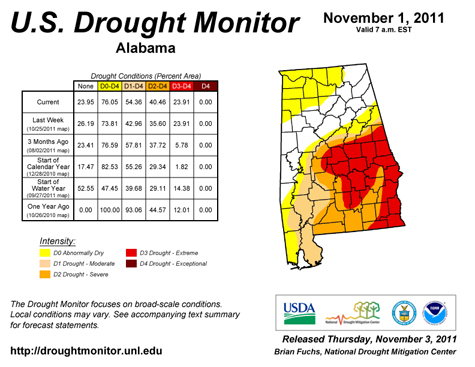 |
|||||||||||||||||||||||||||||||||||||||
| Copyright (c) 2010-2011 Alabama Office of the State Climatologist. All rights reserved. questions about this web page? Contact webmaster. |
|||||||||||||||||||||||||||||||||||||||
